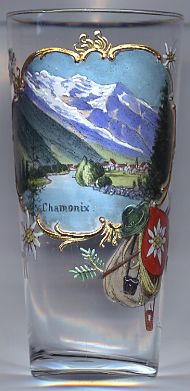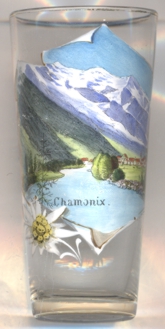

|
| FRANCE | FRANCE |
| région: Auvergne-Rhône-Alpes | |
| département: 74, Haute-Savoie |
 Chamonix-Mont-Blanc or, more commonly, Chamonix, is situated at an elevation of 1,032 m in the Chamonix valley in the département
Haute-Savoie of Eastern France. Situated near the massive peaks of the Aiguilles Rouges, Chamonix shares both the summit of Mont Blanc and the
title of highest commune in France with its neighbouring commune, Saint-Gervais-les-Bains. The municipality has a population of about 9,500 (2006).
With an area of 245 square kilometers, Chamonix is the fourth largest commune in mainland France.
The valley, about 17,5 km in length, has about 10,000 permanent residents and was originally created by glaciers.
The Arve, one of the principal water channels in the department of Haute-Savoie, originates in Le Tour and flows through Chamonix.
To the northwest rises the rugged Le Brévent (2400m) and Aiguilles Rouges (3000m), while the snowclad summit of Mont Blanc towers
above the valley from the southeast. At 4810m, Mont Blanc is the highest mountain in the European Alps.
Chamonix-Mont-Blanc or, more commonly, Chamonix, is situated at an elevation of 1,032 m in the Chamonix valley in the département
Haute-Savoie of Eastern France. Situated near the massive peaks of the Aiguilles Rouges, Chamonix shares both the summit of Mont Blanc and the
title of highest commune in France with its neighbouring commune, Saint-Gervais-les-Bains. The municipality has a population of about 9,500 (2006).
With an area of 245 square kilometers, Chamonix is the fourth largest commune in mainland France.
The valley, about 17,5 km in length, has about 10,000 permanent residents and was originally created by glaciers.
The Arve, one of the principal water channels in the department of Haute-Savoie, originates in Le Tour and flows through Chamonix.
To the northwest rises the rugged Le Brévent (2400m) and Aiguilles Rouges (3000m), while the snowclad summit of Mont Blanc towers
above the valley from the southeast. At 4810m, Mont Blanc is the highest mountain in the European Alps.
 The valley was first mentioned in 1091, when it was granted by the Count of the Genevois to the great Benedictine house of St. Michel de la Cluse,
near Torino, which by the early 13th century had established a priory there. However, in 1786 the inhabitants bought their freedom from the canons of
Sallanches, to whom the priory had been transferred in 1519.
In 1530, the inhabitants obtained from the Count of the Genevois the privilege of holding two fairs a year, while the valley was often visited by the
civil officials and by the bishops of Geneva (first recorded visit in 1411, while St. Francis de Sales came there in 1606).
The growth of tourism in the early 19th century led to the formation of the Compagnie des Guides de Chamonix in 1821, to regulate access to the mountain
slopes (which were communally or co-operatively owned), and this association held a monopoly of guiding from the town until it was broken by French government
action in 1892; thereafter guides were required to hold a diploma issued by a commission dominated by civil servants and members of the French Alpine Club
rather than local residents. The commune successfully lobbied to change its name from Chamonix to Chamonix-Mont-Blanc in 1916. The holding of the first
Winter Olympic Games in Chamonix in 1924 further raised Chamonix's profile as an international tourist destination. By the 1960s, agriculture had been reduced
to a marginal activity, while the number of tourist beds available rose to around 60,000 by the end of the 20th century, with about
5 million visitors a year.
The valley was first mentioned in 1091, when it was granted by the Count of the Genevois to the great Benedictine house of St. Michel de la Cluse,
near Torino, which by the early 13th century had established a priory there. However, in 1786 the inhabitants bought their freedom from the canons of
Sallanches, to whom the priory had been transferred in 1519.
In 1530, the inhabitants obtained from the Count of the Genevois the privilege of holding two fairs a year, while the valley was often visited by the
civil officials and by the bishops of Geneva (first recorded visit in 1411, while St. Francis de Sales came there in 1606).
The growth of tourism in the early 19th century led to the formation of the Compagnie des Guides de Chamonix in 1821, to regulate access to the mountain
slopes (which were communally or co-operatively owned), and this association held a monopoly of guiding from the town until it was broken by French government
action in 1892; thereafter guides were required to hold a diploma issued by a commission dominated by civil servants and members of the French Alpine Club
rather than local residents. The commune successfully lobbied to change its name from Chamonix to Chamonix-Mont-Blanc in 1916. The holding of the first
Winter Olympic Games in Chamonix in 1924 further raised Chamonix's profile as an international tourist destination. By the 1960s, agriculture had been reduced
to a marginal activity, while the number of tourist beds available rose to around 60,000 by the end of the 20th century, with about
5 million visitors a year.
[Text adapted from http://en.wikipedia.org/wiki/Chamonix-Mont-Blanc, http://fr.wikipedia.org/wiki/Chamonix-Mont-Blanc]
![[scale]](lineal.jpg)